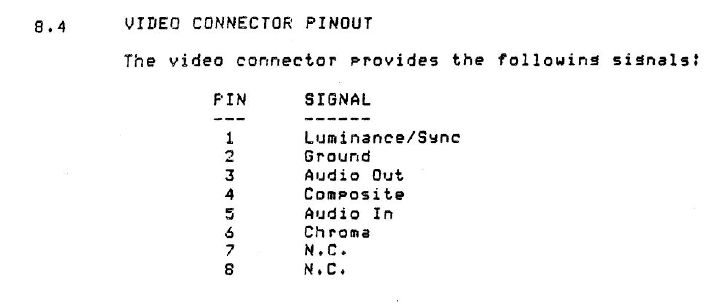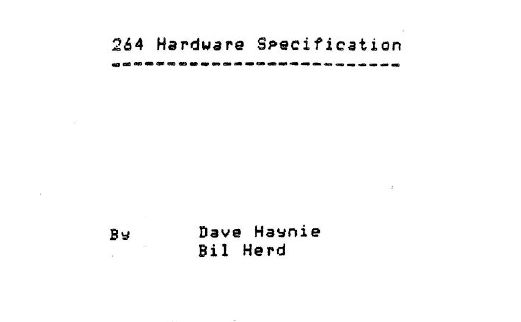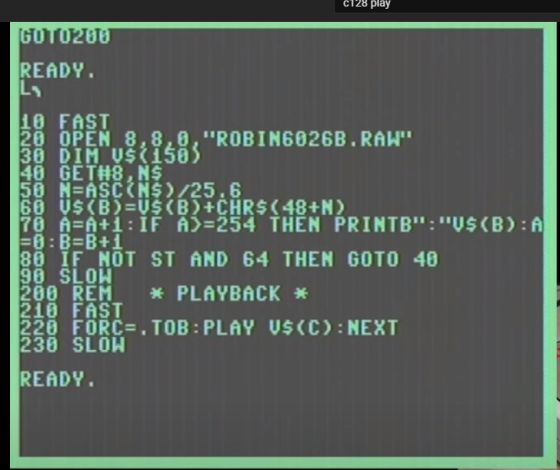| Posted By

C=Owl27
on 2020-11-02
13:06:25
 |  Video Socket Pin5 is Another Audio Output. Proof. Video Socket Pin5 is Another Audio Output. Proof.
Pin5 is Another Audio Output. Proof.
Hello Plus4world.
Having trouble finding out if the TED chip has in input at pin5 I made a cord to test the pins.
Earlier I followed a tutorial describing this pin causing noise to the picture.
It was suggested that pin5 be sent to ground.
Having did that my resulting picture was completely scrambled.

Somebody suggested that the TED chip, like the C64 SID chip, also has an audio input.
I wasn't sure because I found several sources saying the contrary.
But did also find information saying pin5 is an audio input.
So I made a cord to test this.



To demonstrate I made a quick video showing the results of my test.
Link to video: ufile.io/44tkwz0e
My test revealed pin5 is indeed an audio output.
It could be that people have over the years simply barrowed from what was known about the C64
without bothering to test it.
Or if TED does have an input, it may be accessed from somewhere else.
Maybe by the top unused pins by the C64. Or user port maybe.
|
|
Posted By

gerliczer
on 2020-10-29
05:38:18
|  Re: Video Socket Pin5 is Another Audio Output. Proof. Re: Video Socket Pin5 is Another Audio Output. Proof.
Or it could be some leakage. Have you checked the schematics? One would expect it to be properly insulated or decoupled or whatever (IDK how people knowing electronics say it) but we are talking about well over 30 years old hardware. What do you think?
|
|
Posted By

Ulysses777
on 2020-10-29
16:44:19
|  Re: Video Socket Pin5 is Another Audio Output. Proof. Re: Video Socket Pin5 is Another Audio Output. Proof.
That pin is audio in.
The reason you can hear audio through that pin is because of the different way that external audio is handled on the 264 series.
While the SID chip has a dedicated pin for receiving external audio, the TED does not, so instead, external audio is mixed into the TED's audio output on the PCB via a polarised electrolytic capacitor.
So when you connect pin 5 to ground, or through a speaker, you're actually pulling the TED audio out through this mixer circuit, but more importantly, backwards through the aforementioned capacitor, which is a bad move.
|
|
Posted By

C=Owl27
on 2020-11-01
01:07:08
 |  Re: Video Socket Pin5 is Another Audio Output. Proof. Re: Video Socket Pin5 is Another Audio Output. Proof.
Thank you for the information.
So the cords being used with with the C64 could do damage to the TED or computer.
Fortunately I only tested it twice, the second time for the video.
I did find a page, but now on waybackmachine, that said this pin was an
audio OUT but at half a volt, wilt the other pin was a full volt.
web.archive.org/web/20131217180653/http://www.1000bit.it/SUPPORT/SCHEMA/plus4/puls4videoout.jpg
As well as Ray Carlsen also described this pin as a second audio out.
Fascinating! Is it possible to plug in a standard microphone into the pin (with adapter)?
I would really like to test the capability.
But maybe it was a peripheral that utilized the functionality.
Is there a music program available that can handle external audio?
|
|
Posted By

gerliczer
on 2020-11-01
05:07:45
|  Re: Video Socket Pin5 is Another Audio Output. Proof. Re: Video Socket Pin5 is Another Audio Output. Proof.
Any programme that uses an SID-card uses that input but through the Expansion Port instead of the Video Connector. You should check the collection of original information instead of bits and pieces found here and there on the Internet. You should browse the archive created by Bo Zimmerman at http://www.zimmers.net/anonftp/pub/cbm/index.html. There you can find a plethora of information on all Commodore 8 bit computers and a lot of their peripherals.
|
|
Posted By

MMS
on 2020-11-01
09:06:00
 |  Re: Video Socket Pin5 is Another Audio Output. Proof. Re: Video Socket Pin5 is Another Audio Output. Proof.
So, I think the best to refer back to Bil Herd's and Dave Haynie's original platform description.
I just simple clone it here from the PDF "264 hardware specification".
Everything else could be simply questionnable, may contain mistake, bugs. These guys developed this computer, and knowing them inside out, or at least did.
(although Bil left after Cq28 project, Dave was in the development teams of several iconic computers, like A2000, A3000, A1200 and ZorroIII bus)


The leak is highly suspected, especially the strange behaviour of the computer.
Maybe there is a short circuit or extra soldering material between the pins, maybe a too long cut wire bent and reaching ground or the EMC protection shield, etc
|
|
Posted By

C=Owl27
on 2020-11-01
16:33:54
 |  Re: Video Socket Pin5 is Another Audio Output. Proof. Re: Video Socket Pin5 is Another Audio Output. Proof.
Then there are programs, but for the SID?
And maybe these are not compatible with basic 3.5?
But I hope the commands are similar enough.
I could not find anything about audio input commands in the manual. (+4)
Yes there is something wrongish about my +4.
Some random startups are scrambled.
The reset button often doesn't work.
However sometimes I mash it in far enough it may work.
But often doesn't.
So I have to use on/off switch.
Other times I get random F key pressings.
Still other times random breaks.
It seems intermittent, once I get a clean startup it tends to stay working fine.
But when I load or run games then things tend to get a little screwy.
I suspect a bad PLA.
Somebody said it is rarely the PLA,
however I've heard it said that the 264 PLAs commonly fail.
By several people.
Funny enough I think someone here just had a bad PLA too.
But so far people here seem to think there is a short on thew board somewhere.
I removed the bottom shield already.
I can see that somebody has already replaced the 3+1 chips because their tarnish is newer.
However they still are not working.
This is how it came to me, the software not working.
And damn those chips are really in there.
And near the TED shield, so how am I going to get a 'grabber' in there?
I am afraid to use a flat head screw driver, and don't want to damage the board
underneath the chips.
Before I do anything,
I would really like to use the diag264.
I have a minipro tl866 and burned some st m27c512s.
Firsrt I burned just the 16k diag264, and this didn't work.
Then I quadrupled it to 64k,
But this only produced a single character filled on the screen, but nothing else.
I am using the openC16cart pcbs.
The headers are set to the website's suggestions.
Middle:Top:Top:Bot:Bot Middle:Top:Top:Bot:Bot
I don't know what else to do now.
I guess order some 27c128s instead and burn a 16k diag264 to it and try that.
Other then that just use the service manual suggestions and check the voltages and continuities.
And scan with a magnifying glass.
I could replace the 3+1 with the chips I burned, but wow those are hard to get out.
|
|
Posted By

gerliczer
on 2020-11-02
03:39:05
|  Re: Video Socket Pin5 is Another Audio Output. Proof. Re: Video Socket Pin5 is Another Audio Output. Proof.
Then there are programs, but for the SID?
There are demos, games and some utilities that support or require an SID-card.
And maybe these are not compatible with basic 3.5?
What?
But I hope the commands are similar enough.
Yes, POKE and PEEK works the same as in the C=64. Just the SID base address differs.
I could not find anything about audio input commands in the manual. (+4)
As there's no such thing. (For that matter, neither in any 8 bit machine's BASIC, ever.) Remember, audio input is directly mixed into the audio output as Ulysses777 already mentioned.
|
|
Posted By

MMS
on 2020-11-02
07:41:04
 |  Re: Video Socket Pin5 is Another Audio Output. Proof. Re: Video Socket Pin5 is Another Audio Output. Proof.
Most of gerliczer's answer is correct.
Except "As there's no such thing. (For that matter, neither in any 8 bit machine's BASIC, ever.)"
C128's BASIC supported the waveform programming (ENVELOP) and even music playback (PLAY, TEMPO) from BASIC for SID.
Octasoft BASIC 7.0 on a cartridge supported the exact same commands, if you are lucky, they kept it for SID, and used the same SID address as the original C64 / 128 one.
In this case just the SID address need to be changed on the SID card (possible to change) or in the emulator. There is a jumper for this on the card, but even in the YAPE you can change the base address between the original C64 and Plus/4 typical register start address.
I never tested, how if somehow they could manage it on TED (would be a miracle, waveform and multichannel music playback, eh). The commands gave no sound on TED, so there is a chance.
On this link you can find the Hungarian description of Octasoft BASIC
The best would first try it in emulator. Still I do not have the time, but I am curious too. (but can be burned into EPROM, and used in real machine, I suppose it would work instead of 3+1 ROMs too, no?)
http://www.amiga.hu/amigos/plus4/plus4/basic7/octasoft_b70.pdf
This is how you need to set it up:
http://www.amiga.hu/amigos/plus4/plus4/basic7.htm
In the Hungarian text you certainly have no luck to fully understand it, but I have two good news:
-They seems to be 100% clone of the C128 commands, so any C128 English BASIC documentation for the command will do the job
-If you check out the ENVELOPE and PLAY commands, you find some example programs too.
The Hungarian tester told, that the PLAY command seems to did something, but he hear nothing on TED.
It means, that Octasoft programmer may kept the original routines with the SID, and as the Plus/4 had no SID, he heared nothing. But with a SID card it could be an other story.
|
|
Posted By

gerliczer
on 2020-11-02
11:42:55
|  Re: Video Socket Pin5 is Another Audio Output. Proof. Re: Video Socket Pin5 is Another Audio Output. Proof.
Audio input commands and commands to input audio features into a programme are different things to me.
|
|
Posted By

C=Owl27
on 2020-11-02
12:59:34
 |  Re: Video Socket Pin5 is Another Audio Output. Proof. Re: Video Socket Pin5 is Another Audio Output. Proof.
Yes, POKE and PEEK works the same as in the C=64. Just the SID base address differs.
Amazing! I hope to test this or somebody can test it soon.
C128's BASIC supported the waveform programming (ENVELOP) and even music playback (PLAY, TEMPO) from BASIC for SID.
Maybe if I am correct, that wav files (in appropriate settings) could be fed into the SID?
Octasoft BASIC 7.0 on a cartridge supported the exact same commands, if you are lucky, they kept it for SID, and used the same SID address as the original C64 / 128 one.
Wow. I loved Basic7 growing up. When we upgraded to the 128 I migrated my plus4 programs to it. So much so that I stayed with the 128.
(but can be burned into EPROM, and used in real machine, I suppose it would work instead of 3+1 ROMs too, no?)
Yesterday I wondered the very same thing.
Replacing with basic7.
When I placed the diag264 into the 3+1 slot,
it autoran without me having to enter the F1 code.
Which was a downer because I was hoping that cartridges could be told to load,
rather the auto load.
But for basic7 that isn't such a bad thing.
Now that I know my programmer/programming works,
I would like to burn 8 programs to one cartridge.
However I am very nervous about choosing the wrong program.
Some programs do something while uncrunching that causes my TV to loose sync. (I'm guessing its uncrunching)
And others are for PAL, which isn't mine.
The diag264 "knows" if the +4 is one or the other, so I hope other carts do the same.
|
|
Posted By

MMS
on 2020-11-02
16:35:08
 |  Re: Video Socket Pin5 is Another Audio Output. Proof. Re: Video Socket Pin5 is Another Audio Output. Proof.
gerliczer, thanks for correction. Audio INPUT commands.. Sorry, I missed that.
UPDATE:
Octasoft7.0 work ONLY with TED, and SID gives no sound at all at $D400, or at $FD40/FE80.
The ENVELOPE function does a little change on the Attack phase. no waveform change happens
TEMPO and PLAY works in a limited form, some commands just does not work.
------So all below is for C128 only---OFF------------------------
Maybe I have something for you.
I recently saw a video from a great programmer, Robin how to play on C128 wav files with simple BASIC commands. It uses FAST mode, but the Plus/4 switched off screen (almost identical function, and probably implemented in Octasoft 7.0 too) provides very similar speed as C128 2MHz.
This is the code, certainly the uncompressed headerless RAW file should fit into the memory, and as told by him, it mainly works with 6581 SID, because the newer SID chip has much lower level digi sound ("noise")
https://www.youtube.com/watch?v=hpkJRZZL6Bw

I suppose IF the Octasoft 7.0 uses the original SID address, and you use the same PLAY command, it may work.
A faster loading version:
http://psw.ca/prg/c128sample2.d64
I suppose loading a digital RAW file in this format is much easier than to create a digitizing program, and probably the quality is better too
(you can write a playback routine in assembler, if you find this BASIC code too noisy)
(Yeah, last idea, and then go for testing: the Digiblaster provides 8 bit playback, so theoretically an 8 bit RAW could be played back without major quality drop, but the file fize become much bigger then)
|
|
Posted By

C=Owl27
on 2020-11-02
23:39:25
 |  Re: Video Socket Pin5 is Another Audio Output. Proof. Re: Video Socket Pin5 is Another Audio Output. Proof.
I can't wait to try it.
Now I have several BIN files to 'join' into 2 64k bins.
And I will burn these to two chips on my openc16cart board.
And with the jumpers I will be able to hot swap which program ends up loading.
The first one will be basic 7.
Which gave me an idea.
Would it be possible to load and run games designed for the 128 on a plus 4,
if the basic 7 had be activated?
Also is there a basic2.0 for the plus 4?
If so is there a BIN of basic2.0 for the plus4?
And if there is would that make C64 games compatible with the plus4?
|
|
Posted By

MMS
on 2020-11-03
17:29:09
 |  Re: Video Socket Pin5 is Another Audio Output. Proof. Re: Video Socket Pin5 is Another Audio Output. Proof.
Octasoft 7.0 is told to be token compatible with the C128 BASIC, but I hardly believe (due to HW limitations) that the code will run in the same way, or may not give some syntax error codes (like ENVELOPE or PLAY in some cases)
BASIC 2.0 on Plus/4: Yes it will work. The only thing you need to take care the POKE commands in the C64, may set the color or create sounds, or directly referring the character or gfx screen memory (and color memory)
SVS Ultimate map provides a lot of hint, how to convert them.
Certainly the machine code routines of C64 need complete rewrite, especially if works with interrupts, and the HW sprites will definitely not work on +4.
In fact, there is a BASIC 3.5 for C64, a much better choice, as you have almost everything 
The POKEs should work witout change, but you can add structure programming and GFX commands.
From this aspect the C128 is the best choice: it knows every trick the C64 hardware knows, and have a BASIC even better than Plus/4 Basic.
|
|
Posted By

C=Owl27
on 2020-11-07
14:11:28
 |  Re: Video Socket Pin5 is Another Audio Output. Proof. Re: Video Socket Pin5 is Another Audio Output. Proof.
I learned to program on Plus4, then 128.
When I finally got around to trying to use the C64,
I was surprised that none of my programs would work on it.
And I gave up quickly writing a new one.
I couldn't do without the expanded list of commands from the later computers.
Sadly when I burned the basic7 to a chip it did not load.
I also combined it with other 16k games and programs.
Micro illustrator, jack attack and viduzzles.
Those worked when I adjusted the headers on the cartridge pcb.
The only one that didn't work was the only one I cared about working,
the Basic 7. 
I would go on to quadruple just the basic7 to 64k
and go on to burn just that.
But I am afraid to loose another chip to it if it doesn't work a second time.
EDIT:
I went ahead and burned another Basic7 but it too does not work.
The second time I used a different bin file but the result is the same.
Has any one ever had a problem burning Basic7 (octasoft)?
I am using it as a cartridge.
But maybe this is meant to replace the basic rom inside?
I will try that next.
Is basic 7 meant to be used as a cartridge?
|
|
Posted By

MMS
on 2020-11-07
19:03:50
 |  Re: Video Socket Pin5 is Another Audio Output. Proof. Re: Video Socket Pin5 is Another Audio Output. Proof.
When it worked for me in the emulator, it was in the position of C3, I mean external cartridge.
|
|
| |
Copyright © Plus/4 World Team, 2001-2025. Support Plus/4 World on Patreon |